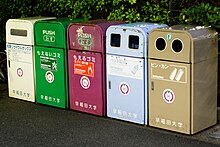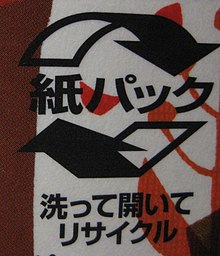Recycling in Japan
This article needs to be updated. (November 2016) |

Recycling in Japan (リサイクル, Risaikuru), an aspect of waste management in Japan, is based on the Japanese Container and Packaging Recycling Law. Plastic, paper, PET bottles, aluminium and glass are collected and recycled. Japan's country profile in Waste Atlas shows that in 2012 Recycling Rate[clarification needed] was 20.8%.[1][specify]
Container and Packaging Recycling Act
[edit]
Also called Act on the Promotion of Sorted Collection and Recycling of Containers and Packaging, has been enforced since April 1997 by the Ministry of the Environment to reduce the waste of glass containers, PET bottles and paper cartons. Since April 2000 plastic containers and packages other than PET bottles have been included.[2][3] According to the act, the recycling is conducted by the Japanese Container and Package Recycling Association (JCPRA) (財団法人日本容器包装リサイクル協会, Zaidan-hōjin Nihon-yōki-hōsō-risaikuru-kyōkai), a government-designated organization established September 25, 1996.[4]
| Product | Volume of recycling tons |
Change since 2000 |
Recycling unit costs ¥ / kg |
Change since 2000 |
|---|---|---|---|---|
| Glass bottles, no color | 155,076 | -16.04% | 4.1 | -1.23% |
| Glass bottles, brown | 133,560 | +43.62% | 5.5 | -28.40% |
| Glass bottles, other | 107,383 | +10.09% | 9.2 | +13.64% |
| PET bottles | 257,906 | +167.03% | 1.7 | -98.09% |
| Paper | 33,934 | -29.03% | 13.3 | -77.32% |
| Plastics | 853,581 | +463.53% | 65.7 | -37.43% |
- The consumers are required to follow sorting guidelines established by the municipalities.
- The sorted waste is then collected by the municipalities and stored for collecting by the recycling company.
- Manufactures and business entities using containers and packages have to pay a recycling fee to the JCPRA, in accordance with the volume they manufacture or sell.
- Each year recycling business entities are selected by a public bidding in every local municipality where a waste storage site is located. They are assigned to collect and transport the waste from the storage sites to recycling facilities. To make sure the waste is getting recycled, these recycling business entities receive payment only after showing a delivery report, signed by the recipient of the recycled products.

Households in some areas separate their waste and place it in special bags for collection - If an item was disposed of improperly, a large red warning sticker is put on the offending rubbish bag to shame the person responsible.[6]
Recycling of steel cans is not regulated by the law, but in 2006 about 99% of the municipalities collected and recycled them.[7] In 1973 the Japan Steel Can Recycling Association (スチール缶リサイクル協会, Suchiiru-kan Risaikuru kyōkai), a non-profit organization to promote the recycling of steel cans, had been established. According to its statistics 88.1% of steel cans have been recycled in 2006, maintaining the world's highest level.[7]
In 2016, Dr. Yamakawa reported the state of the Packaging Recycling Act in detail,[8] which would be the latest information available in English.
Other recycling acts and target products/materials
[edit]- Home appliance recycling act (特定家庭用機器再商品化法, Tokutei Kateiyō Kiki Saishyōhinka Hō, formally referred to as "Act on Recycling of Specified Home Appliances") - enacted June 1998, enforced April 2001 [9][10]
- Four large electrical home appliances: Air conditioners, television sets (CRT and LCD), refrigerators (including freezers) and washing machines (including cloth dryers).
- Small WEEE recycling act (使用済小型電子機器等の再資源化の促進に関する法律, Siyou Zumi Kogata Denshi Kiki tō no Sai Shigenka no Sokushin ni kansuru Hōristu, formally referred to as "Act on Promotion of Recycling of Small Waste Electrical and Electronic Equipment") - enacted 2012 [11]
- Medium and small electrical and electronic equipment
- Construction material recycling act (建設工事に係る資材の再資源化等に関する法律, Kensetsu Kōji ni kakaru Shizai no Saishigenka tō ni kansuru Hōritsu) - enacted May 2000 [12]
- Food waste recycling act (食品循環資源の再生利用等の促進に関する法律, Shokuhin Junkan Shigen no Saisei Riyō tō no Sokushin ni kansuru Hōritsu) - enacted 2000, revised 2007 [13][14]
- Food waste from industries and business enterprises (Kitchen waste from households are not targeted)
- ELV recycling act (使用済自動車の再資源化等に関する法律, Shiyōzumi Jidōsha no Saishigenka tō ni kansuru Hōritsu, formally referred to as "Act on Recycling, etc. of End-of-life Vehicles") - enacted 2002 [15]
- ASR (automotive shredder residue), airbags, CFCs (Chlorofluorocarbons)
- Act on the Promotion of Effective Utilization of Resources [16] (資源有効利用促進法, Shigen Yukō Riyou Sokushin Hō) - enacted May 2000 replacing "Act on the Promotion of Effective Utilization of Resources",[17] enforced April 2001
- Designated resources-saving industries
- Designated resources-reutilizing industries
- Specified resources-saved products
- Specified reuse-promoted products
- Specified labeled products (Required to be labeled to facilitate separated collection as shown in the Symbol section)
- Specified resources-recycled products (Required to promote self-collection and recycling)
- Compact rechargeable batteries[18] (sealed lead acid batteries, sealed nickel-cadmium batteries, sealed nickel-metal-hydride batteries, lithium batteries)
- Personal computers (including CRTs and liquid crystal displays)
- Specified by-products Required to promote the use of by-products as recyclable resources
- Green procurement act (グリーン購入法, formally referred to as Act on Promotion of Procurement of Eco-Friendly Goods and Services by the State and Other Entities) - enacted May 2000, enforced April 2001 [19][20]
- To promote purchase of recycled products
- Act on Promotion of Resource Circulation for Plastics (プラスチックに係る資源循環の促進等に関する法律, Plastic ni kakaru Shigen Junkan no Sokushin tou ni kannsuru Hōritsu) - The cabinet decided the bill [21] in March 2021, and the act was enacted on 11 June 2021. It will enter into force within a year.
Symbols
[edit]
 |
Paper (紙, Kami) |
| Plastic (プラ, Pura) | |
| Aluminum (アルミ, Arumi) | |
| Steel (スチール, Suchiiru) | |
 |
PET bottles |
Recycling plans
[edit]On March 25, 2008, the Japanese Cabinet approved a plan that targets to reduce the total waste from about 52 million tons in 2007 to about 50 million tons in 2012 and to raise the waste recycling rate from 20 to 25%. Thermal recycling and a charging system for waste disposal services will be promoted.[22]
3R Initiative
[edit]This G8 initiative, first proposed at the G8 Summit in June 2004, aims to Reduce, Reuse and Recycle waste.[23] At the G8 Environmental Minister Meeting in Kobe on May 24–26, 2008, the ministers agreed about the Kobe 3R Action plan. It intends to improve resource productivity, to establish an international sound material-cycle society and to bring forward 3Rs capacity in developing countries.[24][25] According to this plan, Japan also announced a New Action Plan towards a Global Zero Waste Society, aimed to establish material cycle societies internationally.[26]
The Japanese government set October as the official month for 3R promotions. This was done to specify and allocate deliberate time to encourage corporations and businesses to focus on the importance of reducing, reusing and recycling waste. During the promotion month, the government and other companies organise informative events and parties to publicise the ideas of a sound material-cycle society.[27]
Scandals
[edit]In January 2008 five paper companies in Japan were accused of misleading customers about the recycled paper content of their products. Oji Paper, the largest paper company in Japan, admitted that its copy and print paper contained 5 to 10% recycled paper, instead of the 50% stated. The president of Oji Paper apologized to its customers, and the president of Nippon Pages, the second largest paper company in Japan, resigned to take responsibility. The Japanese Fair Trade Commission said it would investigate.[28]
See also
[edit]- Recycling
- Sound Material-Cycle Society
- Waste management in Japan
- Electronic waste in Japan
- Mottainai - common Japanese expression, often used in this context
References
[edit]- ^ Waste Atlas(2012). Country Data: JAPAN
- ^ "Japanese Law Translation - Act on the Promotion of Sorted Collection and Recycling of Containers and Packaging".
- ^ "Container and Packaging Recycling Law" (PDF). Ministry of the Environment, Japan. 2005-01-05. Retrieved 2008-11-16.
- ^ "JCPRA Profile". JCPRA. Archived from the original on October 26, 2008. Retrieved 2008-11-16.
- ^ "Recycling statistic". JCPRA. Archived from the original on 2011-06-13. Retrieved 2011-02-19.
- ^ ""Recycling in Japan" or "Reasons to get it right and avoid eternal shame"". SoraNews24 -Japan News-. 2014-05-14. Retrieved 2020-03-23.
- ^ a b "Japan Maintains World's Highest Steel Can Recycling Rate: 88.1% in 2006". japanfs.org. 2007-11-09. Retrieved 2008-11-17.
- ^ Yamakawa, Hajime (2016). "Annex I. The EPR for packaging waste in Japan". In Extended Producer Responsibility: Updated Guidance for Efficient Waste Management. OECD Publishing.
- ^ "METI - Act on Recycling of Specified Home Appliances".
- ^ Hotta, Yasuhiko; Santo, Atsushi; Tasaki, Tomohiro (2016). "Annex H. Recycling of electronic home appliances in Japan". In Extended Producer Responsibility: Updated Guidance for Efficient Waste Management. OECD Publishing.
- ^ "Japanese Law Translation - Act on Promotion of Recycling of Small Waste Electrical and Electronic Equipment".
- ^ "Ministry of Environment - Construction Material Recycling Law" (PDF).
- ^ "Ministry of Environment - Food Waste Recycling Law" (PDF).
- ^ "MAFF - Food Waste Recycling Act" (PDF).
- ^ "Japanese Law Translation - Act on Recycling, etc. of End-of-Life Vehicles".
- ^ Ministry of Economy, Trade and Industry. "Toward a 3R-Oriented Sustainable Society: Legislation and Trend 2010" (PDF). pp. 16–21.
- ^ "Japanese Law Translation - Act on the Promotion of Effective Utilization of Resources".
- ^ Tasaki, Tomohiro (2016). "Annex G. EPR for used rechargeable batteries in Japan". In OECD, Extended Producer Responsibility: Updated Guidance for Efficient Waste Management. OECD Publishing.
- ^ "Japanese Law Translation - Act on Promotion of Procurement of Eco-Friendly Goods and Services by the State and Other Entities".
- ^ "Ministry of Environment - Act on Promoting Green Procurement" (PDF).
- ^ Ministry of Economy, Trade and Industry (2021). "Cabinet Decision on the Bill for the Act on Promotion of Resource Circulation for Plastics".
- ^ "MOE Sets Targets to Reduce Waste, Increase Waste Power Generation and Recycling by 2012". japanfs.org. 2008-09-21. Retrieved 2008-11-16.
- ^ "The 3R Initiative". Ministry of the Environment, Japan. 2008-05-27. Retrieved 2008-11-16.
- ^ "G8 Environmental Minister Meeting". Ministry of the Environment, Japan. 2008-05-25. Retrieved 2008-11-16.
- ^ "Kobe 3R Action Plan" (PDF). Ministry of the Environment, Japan. Retrieved 2008-11-16.
- ^ "Japan's New Action Plan towards a Zero Waste Society" (PDF). Ministry of the Environment, Japan. Retrieved 2008-11-16.
- ^ "History and Current State of Waste Management in Japan" (PDF). Ministry of the Environment. Retrieved 25 March 2020.
- ^ McCurry, Justin (2008-01-18). "Recycling scandal hits Japan". London: guardian.co.uk. Retrieved 2008-11-16.
External links
[edit]- The Japan Containers and Packaging Recycling Association
- 3R Initiative on the Ministry of Environment homepage
- Japan for Sustainability
- PC 3R Promotion Association


